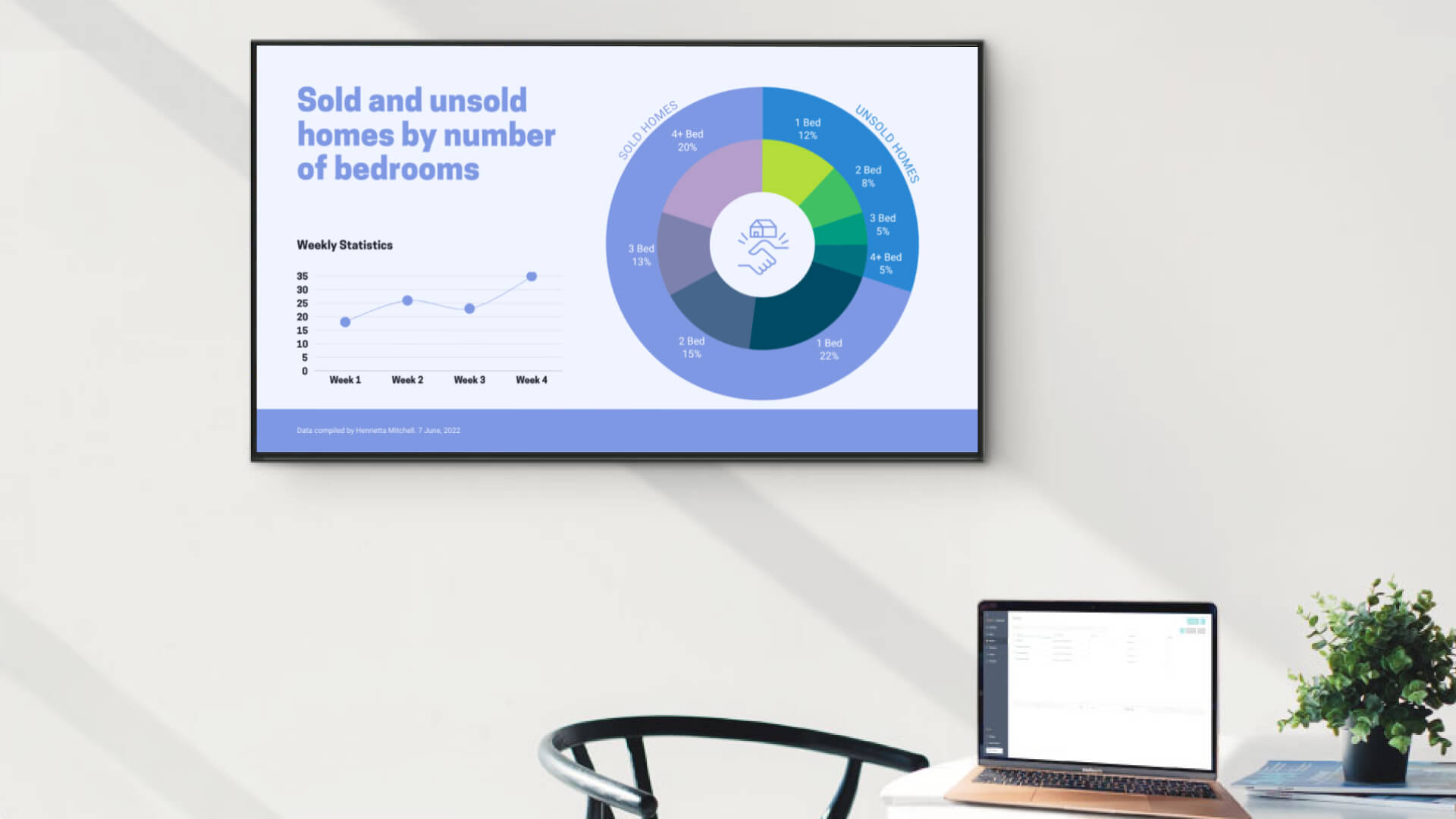
Jul 5 2024
6 min read


Jan
In a world of e-dashboards, digital merchandizing, and whatnot, the technological transformation of sales has become crucial for organizations striving for efficiency and a competitive edge.
Before we get into more details, let’s understand the concept of digital sales boards, its growing significance, components, implementation strategies, and future outlook.
A digital sales board is an interactive platform consolidating data, metrics, and strategies into a single, visually engaging dashboard. It enables your team to track performance, come with attention-grabbing designs, manage customer relationships, and streamline real-time sales processes.

For example, a retail chain could use it to display live updates on sales figures, inventory levels, and customer feedback, allowing managers to make informed, immediate decisions to optimize sales outcomes.
From real-time data accessibility to one-stop performance view for an entire week, month, or quarter, an electronic screen can do it all!
1. Increased productivity
Automating routine tasks can help with easy access to essential tools and information, such a tool can boost the efficiency and productivity of sales teams. A financial dashboard, for example, could automate lead tracking and follow-ups, increasing the efficiency of its turnover process.
2.Pipeline management
The digital sales board should offer an intuitive, real-time visual representation of the sales pipeline, detailing each stage from initial contact to deal closure. Enhanced features could include automated alerts for stalled deals, predictive analytics to identify potential high-value opportunities, and detailed tracking of individual sales rep performance within the pipeline. For instance, a color-coded progress bar can highlight deals at risk, while AI-driven insights can recommend the next best actions to move deals forward.For example, a real estate agency can use it to monitor the stages of property sales, from initial listings to final transactions.

3. Improved decision-making
Integrating analytics and predictive modeling helps make strategic decisions based on trends and forecasts. A software company can leverage predictive analytics to forecast quarterly sales and allocate resources accordingly.
4. Performance metrics and KPIs
Customizable dashboards display key performance indicators, helping teams to focus on critical objectives and benchmarks. An e-commerce platform can showcase real-time metrics like conversion rates, average order value, and customer acquisition costs via an electronic trade board.

5. Integration with other business tools
Seamlessly connects with other business tools like email platforms, accounting software, and marketing automation tools for a unified workflow. A logistics firm can integrate its turnover metrics with its supply chain management system, ensuring alignment between sales forecasts and inventory management.
6. Customer Relationship Management
Sales teams can utilize the digital sales board to get a 360-degree view of customer interactions. This includes tracking communication history, logging customer preferences, and integrating feedback mechanisms. Advanced features like AI-powered sentiment analysis can help sales teams understand customer moods and tailor interactions accordingly. For example, an integrated calendar feature can remind sales reps of follow-up dates, while a collaborative workspace allows team members to share insights and strategies in real-time, ensuring a cohesive approach to customer management.
Book My personalized demo6. Customer Relationship Management
Sales teams can utilize the digital sales board to get a 360-degree view of customer interactions. This includes tracking communication history, logging customer preferences, and integrating feedback mechanisms. Advanced features like AI-powered sentiment analysis can help sales teams understand customer moods and tailor interactions accordingly. For example, an integrated calendar feature can remind sales reps of follow-up dates, while a collaborative workspace allows team members to share insights and strategies in real-time, ensuring a cohesive approach to customer management.
From CRM interfaces to collaborative tools, here is what you need to know
Central to the board, this system amalgamates data from diverse sources such as CRM, ERP, and marketing platforms, ensuring a complete overview of market operations.
This feature tracks the progression of sales opportunities, from initial contact to deal closure, providing a clear view of the sales funnel.
A user-friendly platform that allows sales teams to tailor the layout, metrics displayed, and visual elements to suit their specific needs. Eager to create a sales dashboard using Power Bi? This video might be the one for you.
Ensures that the sales board is partially, if not entirely, accessible on various mobile devices, allowing sales teams to stay updated even on the go.
Features enabling team communication and collaboration include shared notes, task assignments, and feedback loops that enable live action tracking, access to shared notes activity feed, etc., without additional follow-ups.
Protects sensitive data with robust security protocols and ensures compliance with industry regulations and standards. This includes implementing encryption, multi-factor authentication, and regular security audits to safeguard data against unauthorized access or breaches.
The reporting and analytics component should leverage cutting-edge technologies like machine learning and big data analytics to provide deep, actionable insights. Enhanced capabilities could include customizable, interactive dashboards that allow sales teams to drill down into specific metrics, real-time performance tracking, and predictive modeling to anticipate future trends.
For instance, a dashboard could feature widgets that visualize sales data through heat maps, bar charts, and trend lines, making complex data easily digestible. Additionally, integrating natural language processing (NLP) could enable the system to generate narrative reports that explain the data insights in plain language, helping non-technical team members understand and act on the findings.
The global digital transformation market size was estimated at USD 731.13 billion in 2022 and is anticipated to expand at a compound annual growth rate (CAGR) of 26.7% from 2023 to 2030. Let us take a look at some of the chief influential factors
Tailoring sales approaches to individual customer needs will be a focus. Advanced analytics and AI will facilitate the creation of highly customized marketing campaigns and products, boosting customer satisfaction and loyalty.
Advanced analytics tools will transform raw data into valuable insights, aiding in developing targeted strategies and informed business decisions. Data analytics will also be pivotal in monitoring and improving sales team performance.
Enhanced with AI and automation, company consoles will offer intelligent insights and streamline customer management processes. Integration with other tools, such as marketing automation and social media platforms, will further enhance their effectiveness.
Automating repetitive tasks will become more prevalent, increasing efficiency. This shift will free representatives to focus on more complex and relationship-building activities.
Leveraging platforms like LinkedIn and Twitter for lead generation and customer engagement will grow. Sales teams might increasingly use social media analytics to understand customer sentiments and trends.
Digital sales displays represent more than just a technological tool; they are the future of business. Their integration into trade tactics marks a pivotal shift, profoundly influencing operational efficiency, customer delight, and overall success.
Quintessentially, navigating the digital transformation journey with these platforms is not about adoption. It is a competitive advantage leading the charge in the market.
Take complete control of what you show on your digital signage & how you show it.
Start Free Trial Schedule My Demo
Jul 5 2024
6 min read

Jul 1 2024
7 min read

Jun 28 2024
5 min read

Jun 7 2024
7 min read